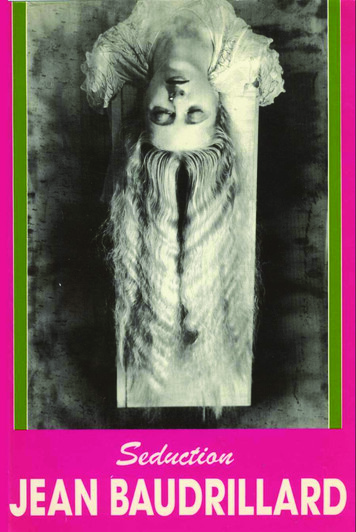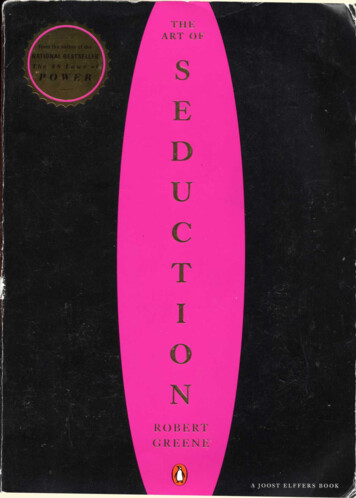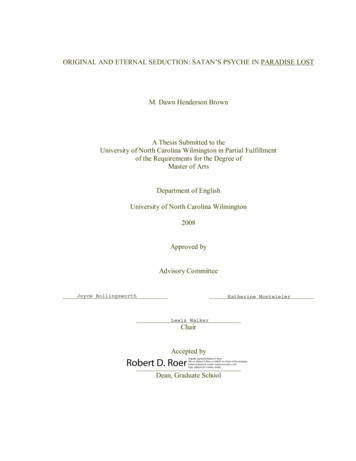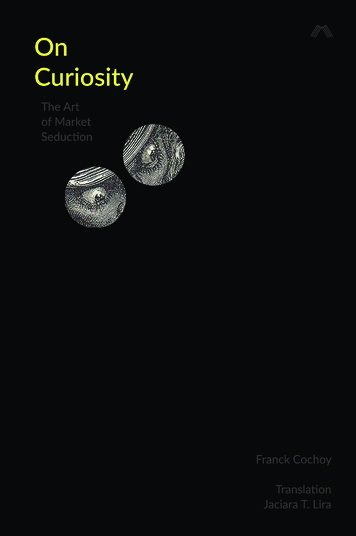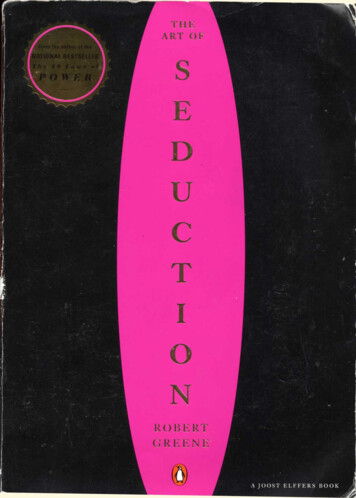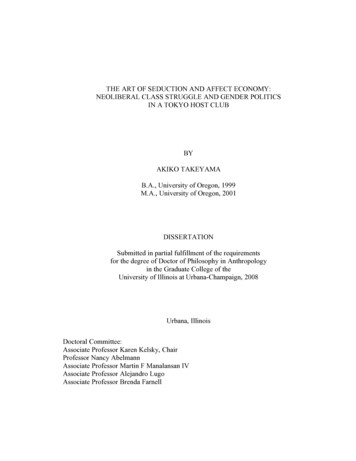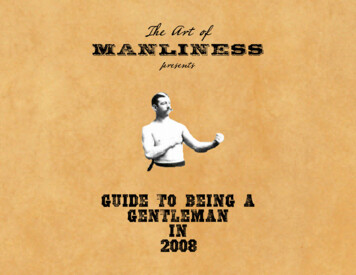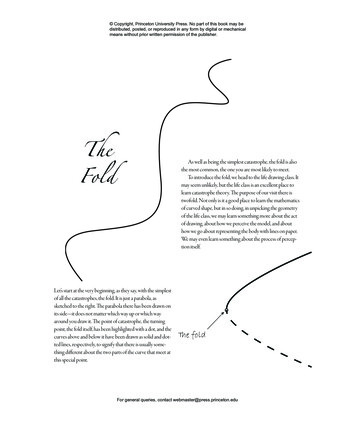
Transcription
Copyright, Princeton University Press. No part of this book may bedistributed, posted, or reproduced in any form by digital or mechanicalmeans without prior written permission of the publisher.TheFoldAs well as being the simplest catastrophe, the fold is alsothe most common, the one you are most likely to meet.To introduce the fold, we head to the life drawing class. Itmay seem unlikely, but the life class is an excellent place tolearn catastrophe theory. The purpose of our visit there istwofold. Not only is it a good place to learn the mathematicsof curved shape, but in so doing, in unpicking the geometryof the life class, we may learn something more about the actof drawing, about how we perceive the model, and abouthow we go about representing the body with lines on paper.We may even learn something about the process of perception itself.Let’s start at the very beginning, as they say, with the simplestof all the catastrophes, the fold. It is just a parabola, assketched to the right. The parabola there has been drawn onits side—it does not matter which way up or which wayaround you draw it. The point of catastrophe, the turningpoint, the fold itself, has been highlighted with a dot, and thecurves above and below it have been drawn as solid and dotted lines, respectively, to signify that there is usually something different about the two parts of the curve that meet atthis special point.The foldFor general queries, contact webmaster@press.princeton.eduMcRobie.indb 56/15/2017 12:34:28 PM
Copyright, Princeton University Press. No part of this book may bedistributed, posted, or reproduced in any form by digital or mechanicalmeans without prior written permission of the publisher.6 T h e F oldlifted outlineoutlineFemale Nude, Henri Gaudier- Brzeska. “Hooray!”said the nude. “At last, a bit of understanding.”Imagine that a student in a life class has drawn the outline ofthe model onto a sketch pad. Imagine also that the teacher, in abreak from normal traditions, takes a felt pen and draws directlyonto the skin of the model, marking out the line of points on theskin that correspond to the outline that the student has drawn onthe pad. We shall call this line on the body the lifted outline to distinguish it from the outline that lives on the sketch pad.3 Note inparticular that the lifted outline is only defined by the presence ofthe student. It is specific to the student’s viewpoint. For anotherstudent there would be a different line along the model’s skin.Pick a general point on the lifted outline and imagine a planeperpendicular to the lifted outline there. This plane makes across- section through the body, and near to the point in question, that cross- section would look something like a parabola, thehallmark of a fold catastrophe. That point, the skin around it, andthe way that the student has seen and drawn it is a fold catastrophe. The model’s body is not actually folded; it is the act of observation, the act of drawing, that has created the fold.lifted outlineThe sectionsurface normaleyelineoutlineThe foldThe outline is a foldThe outline is a fold.For general queries, contact webmaster@press.princeton.eduMcRobie.indb 66/15/2017 12:34:29 PM
Copyright, Princeton University Press. No part of this book may bedistributed, posted, or reproduced in any form by digital or mechanicalmeans without prior written permission of the publisher.T he FoldA life drawing outline is thus nothing other than a catastrophe map, showing the location of the fold catastrophes.With the greatest respect, every line on Henri Gaudier- Brzeska’s Female Nude (opposite) is a catastrophe. That is certainly a new way of looking at life drawing.A little care is needed since the word “fold” so readilyevokes the imagery of folding over a piece of paper or cloth.However, the student did not fold the model’s skin. No oneput a crease along the side of the model’s body. The liftedoutline will cross a smooth expanse of skin devoid of wrinkles and creases. The line is a “fold” only in the catastrophetheory sense, and it exists only because of the person who islooking at the model. Strictly speaking, the fold is in the eyeof the beholder.Notice that the lifted outline separates those regions ofskin that the student can see from those regions that are hidden away over on the far side of the parabola of the fold. IfFemale Nude, Kneeling and Flexing Right Arm, Henri Gaudier- Brzeska. 1914. 7the student were to scan her eye upward, she would see skinand then suddenly nothing. It would thus be justifiable, if alittle flowery, to describe it as “the line where the visible collides with the invisible, where each annihilates the other—aline beyond which is only the void.”Alternatively we could talk of creation. Above the body,the student sees no skin, and as the eye traverses downwardthe eye line hits the body, and the front and back surfaces,the visible and invisible, are “born” at a fold catastrophe. Suchpoetic language is common in mathematics, where solutionsare said to be “born” at fold catastrophes.See how your art teacher responds if you announce,“Today I shall map out the locus of the fold catastropheswhere the visible and invisible are born out of nothingness.”Although this may seem a little like empty word play, itactually touches upon something deeper. One of the drivingforces behind Thom’s program of mathematics was the concept of “morphogenesis,” the emergence of form, and in laterchapters we shall move from merely looking at objects to thedeeper question of how their form may have arisen. Throughout Thom’s work, and throughout this book, there is an underlying theme of creation. It is ever present in that word“genesis.”The Creation by Michelangelo, from the ceiling of the Sistine Chapel. Unbeknownstto Michelangelo, the fold catastrophes on the outline of the naked Adam, on thehand of God, and on the hills behind are all singularities, as is the emergence of format the birth of the Universe, the greatest singularity of all.For general queries, contact webmaster@press.princeton.edu01 McRobie 1-160 Lorraines.indd 76/20/2017 1:38:23 PM
Copyright, Princeton University Press. No part of this book may bedistributed, posted, or reproduced in any form by digital or mechanicalmeans without prior written permission of the publisher.8 T h e F oldThe foldinvisiblevisibleFor general queries, contact webmaster@press.princeton.eduMcRobie.indb 86/15/2017 12:34:30 PM
Copyright, Princeton University Press. No part of this book may bedistributed, posted, or reproduced in any form by digital or mechanicalmeans without prior written permission of the publisher.T he FoldTwo folds back- to- back create an S- shape. The S- shapehas a prominent position in art history, it being Hogarth’s“serpentine line.” It is also the icon of catastrophe theory, theemblematic representation of how a system can be evolvingsmoothly and yet can suddenly and dramatically collapse.Think of the S as a ski slope with an overhanging precipice,such that a skier traveling smoothly down the top slope suddenly drops from the lip to the nursery slopes below. ThisThe S-shape: the icon of Catastrophe Theory 9simple idea is key to understanding how, despite everythingbeing smooth, we can have sudden and discontinuous jumps.Say we have written down some equations to describethe behavior of a physical system. The equations themselvesmay be smooth, such that the solutions to the equations arealso smooth. Such smooth solutions could, however, takethe form of a beautiful S- shape. When our physical systemtries to follow the S, it can’t—it falls from the lip of the precipice, the fold. Sometimes this might be OK—the skiermight land safely and be able to carry on skiing. But sometimes the landing may not be a good one, and the systemjumps from the fold to disaster, to literal catastrophe.A simple example can be found in structural stability theory, with the “snap- through buckling” of a shallow arch. Takea train ticket or playing card and arch it gently between fingerand thumb. When you press down on it you’ll feel it gradually give and then suddenly pop through from convex toconcave. Pushing upward reverses the process, with a steadydeformation followed by a sudden pop back upward.With a piece of card, we can pop backward and forwarduntil we get bored, but if it were a bridge, the first such popwould be a disaster, a catastrophe.LoadLoadpopDeflectionFor general queries, contact webmaster@press.princeton.eduMcRobie.indb 96/15/2017 12:34:30 PM
Copyright, Princeton University Press. No part of this book may bedistributed, posted, or reproduced in any form by digital or mechanicalmeans without prior written permission of the publisher.10 T h e F oldThom first expounded his theory in a work of staggeringgenius, the book Structural Stability and Morphogenesis, published in 1970. It contained a strange mixture of hard- coremathematics interspersed with musings on all sorts of thisand that.Passages such asConsider the easiest case, that of a static field on B T withvalues in a function space L(U, V ). Given two other manifolds U1, V1 , and maps k : U1 U, j : V V1 then g1X L(U,V) induces a field g1X, defined by g1X j g k . Of coursethere is no reason for the evolution operator of g1, inducedfrom the evolution operator of g by a diffeomorphism h : X X of base spaces, to lead to a well- posed problem exceptin the obvious case in which the maps j and k arediffeomorphisms.4give an indication of why the book was never going to be abest seller. Thom’s use of “obvious” and “of course” may bemildly amusing to the non- mathematician, but they showthat Thom is making few concessions to his readers.Cleddau, 1975.The picture above shows the Cleddau Viaduct near Milford Haven in South Wales, shortly after it collapsed in 1975,killing four people. Although the viaduct is not a shallowarch design, the collapse was caused by the sudden bucklingof thin plates above the supporting column. Buckling and catastrophe theory are intimately linked, but so far we havelearned only the first letter of Thom’s alphabet, and we wouldneed considerably greater fluency to explain the Cleddaucollapse.We can see that the steel plates have folded, but these arenot the folds of interest. The fold catastrophes associatedwith buckling live in an altogether different, more abstractspace than the merely visual. The smooth surfaces in question here are “energy surfaces,” mathematical graphs that describe the energy in the deformed structure, and the folds, ifthey live anywhere, live inside the heads of the bridge designers as they look at these energy surfaces in their mind’s eye.Occasionally the folds may be made visible, appearing in stability diagrams on calculation pads or lecture blackboards.For general queries, contact webmaster@press.princeton.eduMcRobie.indb 106/15/2017 12:34:30 PM
Copyright, Princeton University Press. No part of this book may bedistributed, posted, or reproduced in any form by digital or mechanicalmeans without prior written permission of the publisher.T he FoldHere is another passage:When V is an open subset of U, let G(V ) be the set of sections of the map V V induced by U U; there isa canonical restriction map G(V ) G(V ) for V V. Wedefine an object c to be a maximal section ofU U for the restriction operation G(V ) G(V ), . . .5Here Thom redefines the notion of an “object” in a veryaustere mathematical way. I have never fully understood thisdefinition, or its purpose, but it shows just how fundamentalan approach is being taken if we have to start by redefiningsomething as basic as an “object,” something that we all thinkwe already understand.The book’s title is somewhat ambiguous. “Structural stability” makes it sound like it has something to do with whybridges and buildings do not collapse. But Thom does notmean that at all. His phrase “structural stability” refers insteadto a property of the shapes in his alphabet. His shapes are stable shapes. They are—in a sense we shall make precise later—robust. And because of this robustness, you will see themeverywhere.And because these shapes are robust and crop up in allsorts of places, it happens that they crop up in the theory ofbuckling, the theory of the stability of structures. In the library in my department, Thom’s book is filed alongsidebooks devoted to structural failure and building collapse.This is wrong. That isn’t what he meant by structural stability.And yet, oddly, happily, the cataloguing is also absolutelyright.The other word in his title is “morphogenesis.” This is unambiguous. Thom makes it clear from the start that he is interested in why things are the shape they are. In our first fewchapters we shall learn his alphabet by looking at “objects.”But his theory runs much deeper than that. The task he sethimself was not to describe the mathematics of visual observation, of how we see curved surfaces such as bodyscapes andlandscapes. Instead he was trying to explain why things turnout to have the shapes they do. He was trying to solve theriddle of biological form. 11His book opens with a rubric, a quotation from D’ArcyThompson’s ground- breaking work On Growth and Form(1917):The waves of the sea, the little ripples on the shore, thesweeping curve of the sandy bay between the headlands,the outline of the hills, the shape of the clouds, all these areso many riddles of form, so many problems ofmorphology.6From D’Arcy Thompson, On Growth and Form (Cambridge: CambridgeUniversity Press, 1966).D’Arcy Thompson’s book remains much loved by artistsand architects. It notes that many shapes in nature crop upagain and again in diverse circumstances—a jellyfish may bethe same shape as a splash of liquid droplets, for example.D’Arcy Thompson does an excellent job cataloguing thecompendium of natural shapes, and he puts forward mechanical hypotheses that may help explain them. For example, he postulates that asymmetries in the swimming motionof the narwhal may lead to stresses that could explain whytheir tusks grow to have a left- handed screw. Thom’s intent isaltogether different. Without making any attempt to understand the details of the physical or biological processes involved, he is nevertheless trying to provide answers to whyand how the shapes emerge, but purely by thinking about“shape” in a much more abstract and much deeper mathematical way.For general queries, contact webmaster@press.princeton.eduMcRobie.indb 116/15/2017 12:34:30 PM
Copyright, Princeton University Press. No part of this book may bedistributed, posted, or reproduced in any form by digital or mechanicalmeans without prior written permission of the publisher.12 T h e F oldThat Thom was unusual even for a mathematician can beseen from some of the other passages in his book. He museswhether all magic is geometry, and whether military societies“must be at least a three- dimensional manifold in order toadmit a structurally stable ergodic field without singularity.”He claims that art is “a virtual catastrophe” and suggests that tealeaves in teacups “may contain local accidental isomorphismswith the dynamic of human situations.”7Postmodernists of the 1970s loved this, even though—orperhaps because—they had little idea about what he was saying.snapThe S- shape and its associated snap- through behavior canbe seen in the life class. It corresponds to looking over a depression, with the skin rising, falling, then rising again. Thepicture above shows an almost trivial example, looking upover the hip to the back, where what is seen suddenly “pops”as the eye line rises above the hip. If that were the only connection between catastrophe theory and life drawing itwould be a rather weak link. However, there is much more,but so far we have met only the first letter in our Alphabet ofBeautiful Curves: the fold is the first element in our periodictable of organic form, and the S- shape is our first molecule.For general queries, contact webmaster@press.princeton.eduMcRobie.indb 126/15/2017 12:34:31 PM
Copyright, Princeton University Press. No part of this book may bedistributed, posted, or reproduced in any form by digital or mechanicalmeans without prior written permission of the publisher.T he Fold 13foldShidden foldFor general queries, contact webmaster@press.princeton.eduMcRobie.indb 136/15/2017 12:34:32 PM
The Fold 7 A life drawing outline is thus nothing other than a catas- trophe map, showing the location of the fold catastrophes. With the greatest respect, every line on Henri Gaudier- Brzesk

